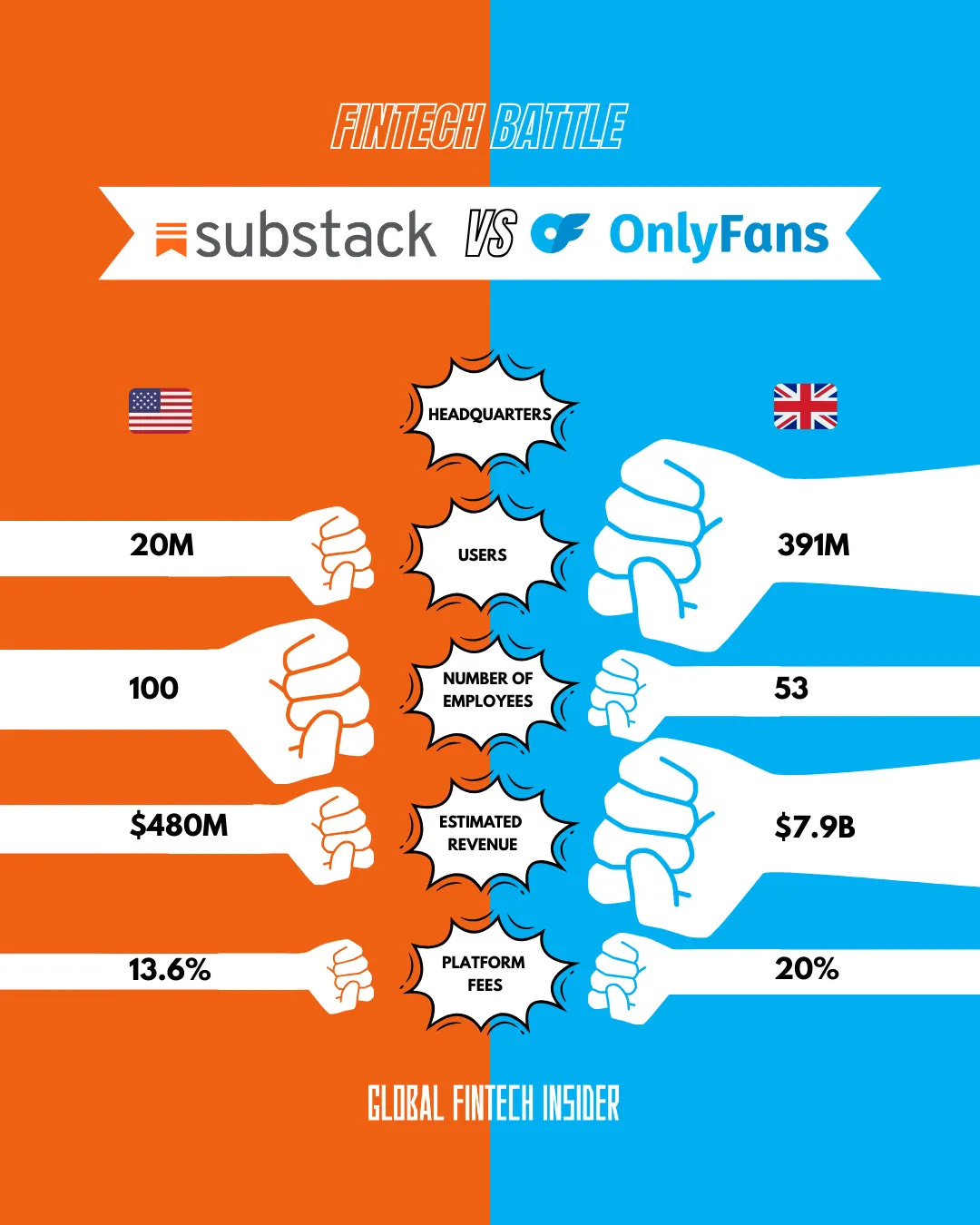OnlyFans vs Substack: Let the Fintech Battle Begin!
The tale of two very similar creator platforms that built billion-dollar empires around recurring subscriptions.
They couldn't look more different on the surface: one platform synonymous with adult content, the other with intellectual newsletters. Yet OnlyFans and Substack are essentially using the same playbook to build a massive recurring subscription business. Both companies created a unified platform making it easy for anyone to distribute their content… while relying on creators’ existing audience to bring in the customers and take a cut of the subscriptions in the process.
Identical DNA, Different Faces
The story begins with a shared blueprint. OnlyFans arrived first in 2016, founded by British entrepreneur Tim Stokely with a vision of direct creator monetization. The platform initially courted fitness instructors and lifestyle content creators before finding unexpected traction in adult entertainment. Substack, founded in 2017, followed with the same core business model, but anchored itself firmly in written content, attracting journalists and thought leaders seeking independence from traditional media outlets.
Revenue Models: Similar Foundations, Different Scales
OnlyFans has transformed into a financial juggernaut. The platform generated $7.9 billion in revenue during 2024, up from $6.6B in 2023. Its user ecosystem now encompasses more than 5.3 million creators serving 391 million fan accounts.
The OnlyFans financial model offers creators 80% of subscription revenue, with the platform retaining 20%. This straightforward split includes both the platform fee and payment processing costs, creating a simplified revenue structure that has proven remarkably effective.
Substack has experienced explosive growth but operates at a smaller scale. The platform recently surpassed 5 million paid subscriptions, up from 3 million just one year ago. Based on an estimated average subscription price range of $8 monthly, Substack's annual revenue likely approaches $480 million.
The Substack revenue model provides creators with approximately 86.4% of subscription revenue after all fees. The platform itself takes a 10% cut, but each creator need to set-up their own Stripe account to sell subscriptions. As a result, Stripe adds approximately 3.6% in fees, which includes 2.9%, plus $0.30 per transaction and an additional 0.7% for recurring payments.
Payment Processing: Different Risk Profiles
The most significant financial difference between these platforms lies in their payment processing relationships and risk profiles. OnlyFans navigates a complex landscape due to its association with adult content, traditionally considered high risk by financial institutions.
The platform relies on Stripe as its payment processor, which makes a special exception for OnlyFans despite typically avoiding merchants in the adult entertainment industry. This relationship has proven tenuous at times. In 2021, OnlyFans nearly abandoned adult content altogether under pressure from card networks.
Adult entertainment provider are either refused or charged higher transaction fees by payment processors due higher risks. One of them is the risk of underage material being sold by the platform. Another one is what payment processors call "friendly fraud", where legitimate purchasers deny making transactions. In many cases, subscribers purchase content discreetly, only to dispute charges when they appear on shared credit card statements.
Substack, on the other hand, don’t even handle payment, letting its creator deal with Stripe directly. Furthermore, since Substack does not allow sexually explicit content, its creators are not considered high risk by payment processor or card networks.
Disrupting Traditional Media and Adult Entertainment
Substack has positioned itself as a disruptor to traditional media companies, a mission deeply rooted in co-founder Hamish McKenzie's background as a former technology journalist at PandoDaily. The platform has triggered an exodus of high profile talent from established media outlets. Writers like Andrew Sullivan from New York Magazine, Glenn Greenwald from The Intercept, Bari Weiss from The New York Times, and Matthew Yglesias from Vox have all abandoned traditional publications for Substack's direct monetization model. More recently, television personalities have followed suit, with Jim Acosta leaving CNN, Joy Reid departing MSNBC, and Paul Krugman exiting The New York Times.
What Substack has done to media companies, OnlyFans has accomplished with adult entertainment studios, creating parallel disintermediation revolutions in their respective industries. Both platforms have eliminated traditional gatekeepers, allowing creators to reach audiences directly without corporate middlemen taking most of the revenue
Perhaps most interestingly, both platforms have dramatically expanded who can participate in their markets. Substack has enabled individuals with no traditional journalism background to build substantial media businesses, with creators like finance writer Byrne Hobart and history writer Heather Cox Richardson achieving subscription numbers that rival established publications. Similarly, OnlyFans has broadened the definition of adult content creators, with celebrities like Cardi B, Bella Thorne, and Blac Chyna launching successful accounts despite having no prior adult entertainment experience.



